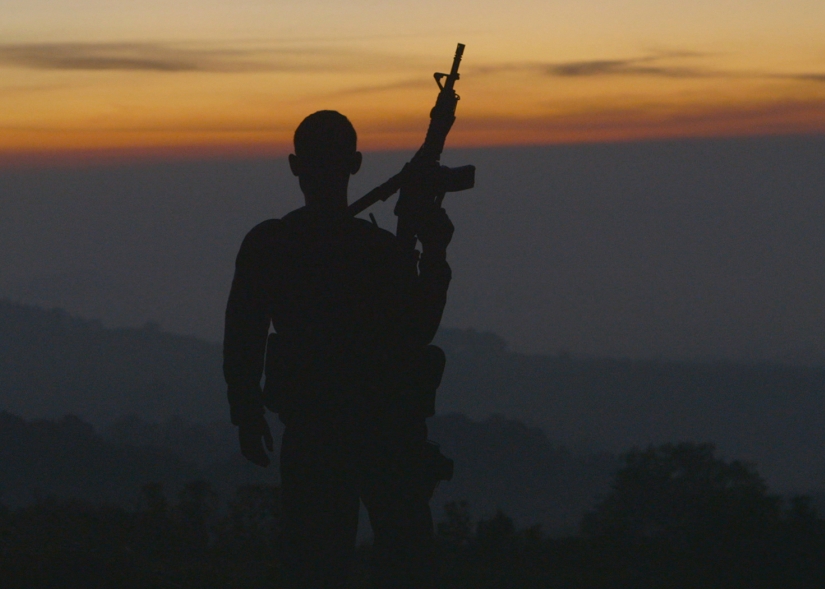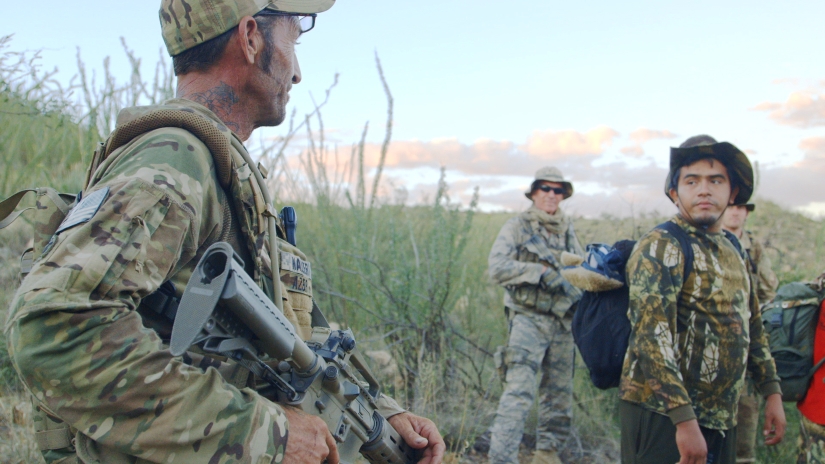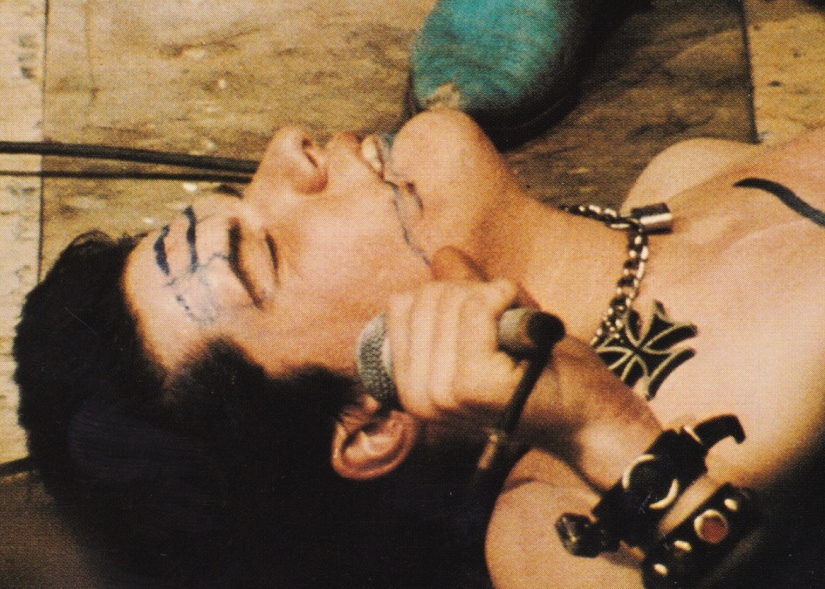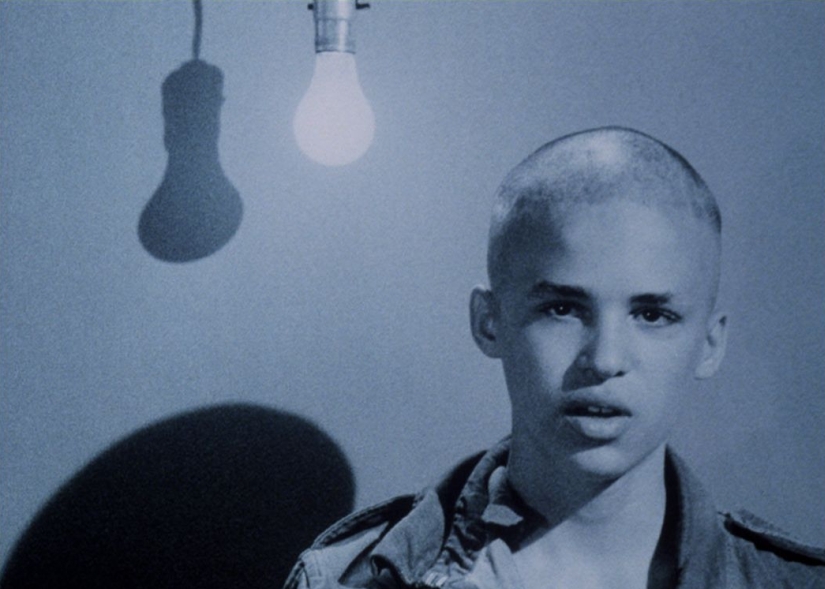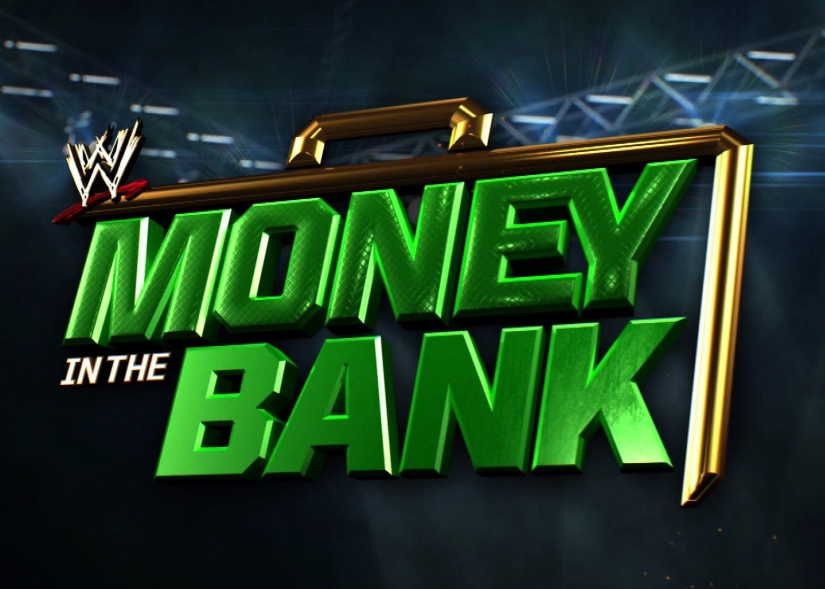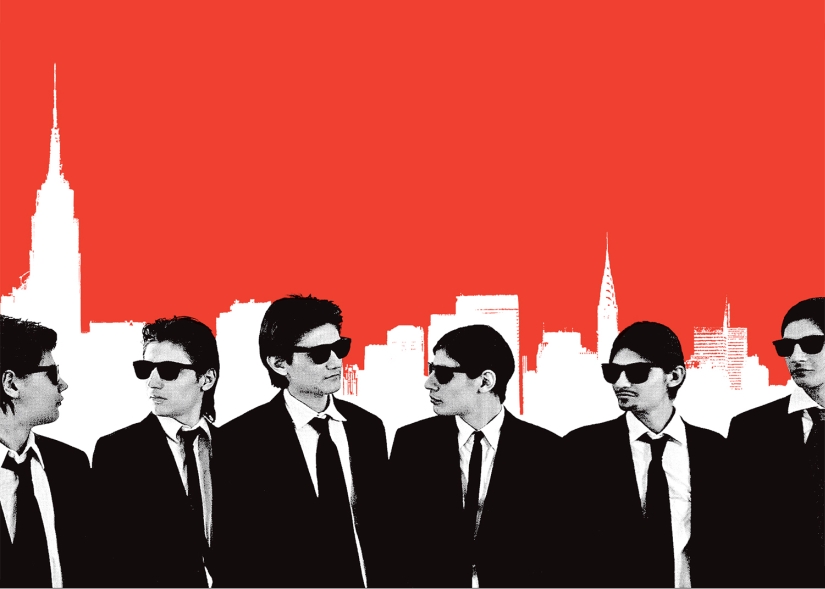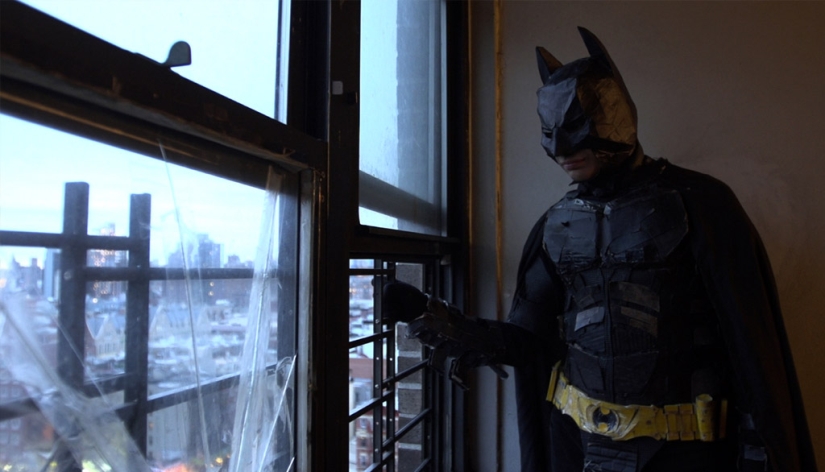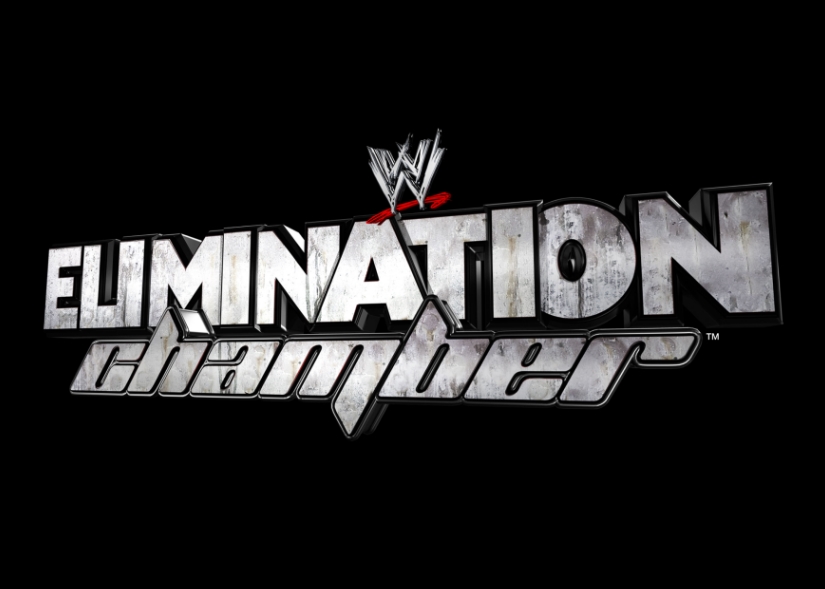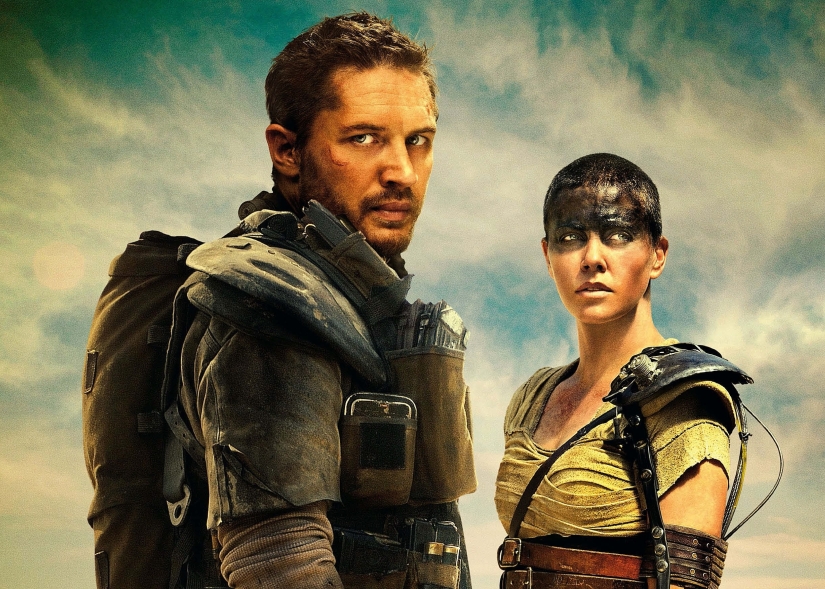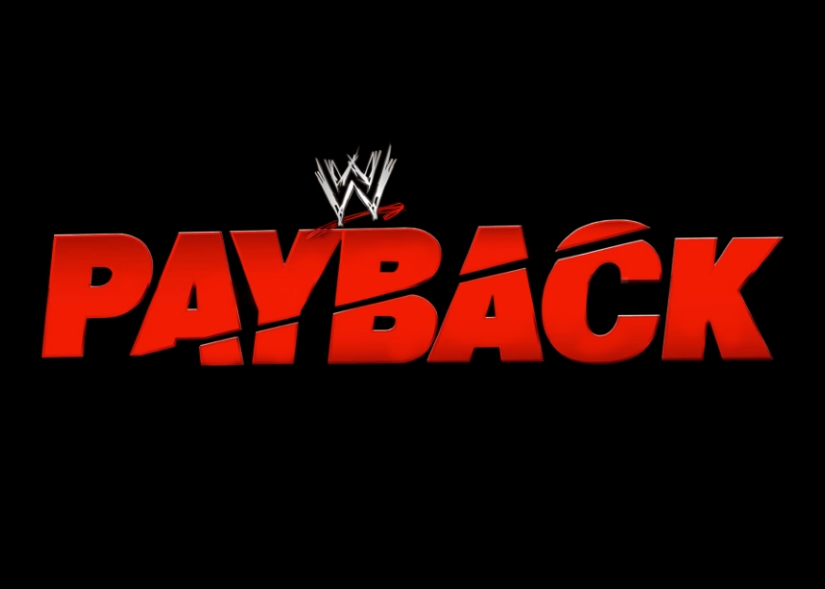Cartel Land Shows Why the War on Drugs May Be Unwinnable
Released last week, Matthew Heineman's documentary Cartel Land has been roundly lauded for its harrowing, on-the-ground chronicle of the Mexican drug war. Heineman trains his lens on two vigilante groups. One is the Arizona Border Recon (ABR), a small militia-like force that patrols the Arizona/Mexico border led by veteran Tim "Nailer" Foley. The other is a much larger Michoacan vigilante organization known as the Autodefensas, led in charismatic fashion by physician Jose Manuel Mireles. Both Foley and Mireles were driven to create their groups by a sense that their respective governments weren't doing enough to confront drug cartels head on. While Foley and Mireles never meet face-to-face in the film, Heineman joins then narratively to compare and contrast these two faces of vigilantism.
Danger is palpable throughout much of Cartel Land, a testament to Heineman's embedded approach and his commitment to it. The camera is there in the thick of shootouts and drug raids south of the border, and we're given ample access to the inner workings of the Autodefensas, both good and bad. Heineman also tags along with Foley in tense and often silent stakeouts to spot border crossers who are purportedly drug mules and/or drug smugglers. (The Arizona Border Recon was originally founded to stop illegal immigrants; the Southern Poverty Law Center considers the ABR an extremist group. Make of that what you will.)
In Manohla Dargis' mixed/negative review of Cartel Land at The New York Times, she said that for all of Heineman's bravery behind the camera, he needed to exercise more of directorial point of view about the war on drugs and vigilantism. Heineman has a point of view, though I think it's quietly articulated in his comparison of the ABR and the Autodefensas, and also the overall narrative trajectory of Cartel Land. The point of view, as it seems to me, is that vigilante groups are ill-suited to address the greater challenges posed by the war on drugs, and that the war of drugs may ultimately be unwinnable (unless you're a drug cartel).
[youtube id="6JD7hPM_yxg"]
As vigilantes, Mireles and Foley seem to embody different heroic ideals in order to propel and even legitimize their groups. Mireles is like some romantic revolutionary of old, coming from the common folk and armed with a compelling personal narrative, the proper face for a populist uprising. Watch him make a speech to a crowd besieged by drug violence, see him interact with fellow members of Autodefensas--there's the air of the charismatic leader, the sort of person who attracts followers through lofty rhetoric and force of will. Mireles' second-in-command is more like Santa Claus than Che Guevara, and he doesn't have nearly the same amount of respect or command of the group. Foley, by contrast, seems taken by the Wild West idea of the cowboy and the gunslinger, even citing old-time notions of vigilantism as a way of justice and making it a way of life. (The spirit of the open frontier may be something inherent in the ideologies of most militia or paramilitary groups.) In that regard, Foley and the ABR posse are the only law left when the fellas with tin stars can't get the job done themselves.
These vigilante and revolutionary ideas are potent fuel for a movement, but they can become complicated by the compromises required to put ideas into meaningful action. That makes up the meat of Cartel Land's second half. We first watch the Autodefensas make major strides against the Knights Templar drug cartel in individual raids, but the purity of the group begins to falter as it becomes bigger and better known. Mireles becomes a media figure for the movement, and as a consequence he and his family are placed in real danger by drug cartels looking to retaliate or to strike first before the Autodefensas get to them. Power grabs within the Autodefensas, malfeasance by its members, abuses of power, and increased interest by the Nieto government in co-opting the movement mean that the Autodefensas may be destined to fail regardless of those initial good intentions.
Foley's group, by contrast, always remains small in scale, and Foley himself never becomes the face of a movement for the media. The operation is small, manageable, and seemingly incorruptible in that regard, but its size means a limited impact on the drug war. The ABR don't seem to win battles in the war on drugs. They don't even necessarily win skirmishes, for that matter. It's unclear what lasting effect they have, if they're a stone thrown in a lake making ripples, or just hail dropping in a pond and vanishing.
If governments and large institutions are ineffective or ineffectual, and if vigilante groups are either hobbled by growth or limited in impact, what solutions are there to the drug war? Similarly, if there's a constant demand for drugs, and if cartels will fill their ranks with new members and new leaders when one of their own is incarcerated and killed in order to meet that demand, is the drug war even worth fighting in the current way it's being fought?
Heineman doesn't present any solutions, but that's not a mark against the things Cartel Land does so well, which is to say its embedded journalism. Documentaries aren't always meant to answer questions. If they can, that's great, but like good philosophers, the primary role of a documentary filmmaker may be to ask the right questions, or to reframe the questions we've been asking, or to reconsider the underlying reasons we ask the questions that we ask.
Eric Kohn points out something important in his Cartel Land review at IndieWire. The film opens with Heinemen watching masked men cook meth in the nighttime. The meth cook says he knows that the drugs will harm people when they're smuggled over the border. That admission seems to acknowledge that the cartel violence in Mexico claims innocent lives and he knows it's just part of the trade. Later in Cartel Land, we hear some of these stories. There's one about babies being murdered, and one about laborers killed at a lime farm because the landowner didn't pay a cartel protection money.
"But what are we going to do?" the meth cook asks. "We come from poverty."
Good question.
The Decline of Western Civilization: To Live and Die in LA
Penelope Spheeris' The Decline of Western Civilization is one of those seminal music documentaries with a great reputation despite being rarely seen. Ditto its two sequels. Never available on DVD or Blu-ray, The Decline of Western Civilization trilogy is finally being released by Shout Factory at the end of the month. In addition, the first two films of Spheeris' Decline trilogy will screen at The Music Box Theatre in Chicago on Saturday, June 27th, with Spheeris in attendance. (For more information about the Music Box screening, click here.)
Even though I've only seen the first Decline, I'm excited for the trilogy's release in general. Maybe the lack of availability has increased the potency of the material and my desire to see it. (Absence makes the heart of the LA scene grow dismaler.) In the first Decline, Spheeris hung around LA punk bands like Black Flag, The Circle Jerks, X, and The Germs and included live concert footage; she caught the daily grind of music mag Slash; she interviewed kids at punk shows. In the process, her documentary captures the spirit of the scene as a whole: an aggressive sneer looking out over the ugly void of the 80s, the logical conclusion after the disillusionment of the 70s and the dashed hopes of the 60s.
Titling the documentary The Decline of Western Civilization seems cheeky, but it's fitting since the story of the movie is the quintessential American tale of the California bummer.
[youtube id="aiCTq_AHcqw"]
Think about it. Before westward expansion was over, the possibilities must have seemed limitless. Land, far as the eye can see, untouched, unspoiled, and with a little genocide, eventually ours. When gold was discovered, the west had riches untold, though only for a few; the rest were ripped off or died trying to eventually get ripped off. With the motion pictures there was the promise of fame rarely achieved, and during the Depression there were jobs that weren't worth the trek. For the generation of love, places like San Francisco seemed utopian, but the promise of the 60s was dashed by political assassinations capped by hippie bloodshed (i.e., the Manson murders, Altamont) that revealed a naive kind of hippie bullshit.
Early in The Decline of Western Civilization, the owner of a punk club stands atop a hill with the LA skyline muggy with haze. Cars on the freeways beneath churn out more and more smog. To paraphrase him, everyone went west expecting paradise, but when they got there, the air sucked.
To put it another way: In Tom Wolfe's The Electric Kool-Aid Acid Test, the summation of the counterculture's failure was the refrain "We blew it"; the equivalent in The Decline of Western Civilization is a disaffected teenager staring at the camera and sighing "Fuck."
While the punk scene seems like it ought to be about community, the film seems to chronicle a form of punk cannibalization. From interviews with punk show kids, they talk about an aggressive and violent streak. In one particular interview, Pat Smear--then of The Germs and later of Nirvana and Foo Fighters fame--admits to beating up girls just because; in the concert footage, pits open up and swirl, full of punk kids and punchy suburban bros and spit. Adding to the vibe of society's lawless decline, the security at the shows are decked out in leather jackets, like the lawmen from the original Mad Max.
It's not just punk-on-punk cannibalization, but in some cases self-cannibalization. Darby Crash of The Germs embodies the latter. He harms himself at shows, scratching his skin and drawing blood. Spheeris catches him on camera zonked out of his gourd. There's permanent marker smeared all over his face and body like he's part poster-child for disaffected youth and part punk-parody in the form of horse hair pottery. Crash slurs out all of the lyrics in a daze while beneath him are subtitles with the proper lyrics. It's funny and sad all at once, though maybe sadder than funny given Crash's eventual suicide from a heroin overdose.
From the clips I've seen, 1988's The Decline of Western Civilization Part II: The Metal Years is less like the first Decline and more like This Is Spinal Tap or the cult short film Heavy Metal Parking Lot. (Spheeris declined to direct This Is Spinal Tap.) The excesses of the second film are about rock star cliches, which might seem like the high-life or a dream fulfilled, but it seems like a steeper fall given the vapid nature of the rock and roll dream. Maybe the focus of The Metal Years was anticipated by the emptiness delineated in X's "Sex and Dying in High Society." 1998's Decline Part III (never released on home video), is all about the homeless gutterpunks of LA and their daily struggles to get by. It's a continued drop headed into the 21st century, because one of the constants of America is the California bummer.
Though not part of the LA punk scene, Johnny Rotten may have succinctly summed the trajectory of the decline of western civilization back in 1977: "No future." The rudderless world continues into the void of the 21st century. West isn't an option anymore, and the only direction left is down. It's fitting that Spheeris would end The Decline of Western Civilization with footage of the band Fear.
4 Must-See Films at BAMcinemaFest 2015 (June 17-28)
BAMcinemaFest 2015 kicks off tomorrow night in Brooklyn. Launched in 2009, the showcase includes some of the finest and most talked-about independent films on the festival circuit from all over the world.
This year's BAMcinemaFest includes the The End of the Tour starring Jesse Eisenberg and Jason Segel, Nasty Baby starring Kristen Wiig and Tunde Adebimpe from TV on the Radio, special retrospective screenings of Larry Clark's Kids and Richard Linklater's Slacker, as well as a sneak preview of Noah Baumbach's Mistress America starring Greta Gerwig.
We were able to catch a few of the films screening at BAMcinemaFest 2015 early. Here are our picks for the four must-see films that are screening over the next week and a half.
For tickets and more information about BAMcinemaFest 2015, visit here.
WWE Money in the Bank 2015: Results and Match Reviews
The passing of Dusty Rhodes last week lent a tinge of sadness to WWE Money in the Bank 2015. In the pre-show, Renee Young was so moved by a tribute to Rhodes that she sobbed her way through the script. At the start of the event, the WWE roster assembled beneath the TitanTron as they tolled the bell 10 times for everyone's favorite common man.
The sincere emotion was one of the most memorable things about Money in the Bank 2015. It was a generally all right pay-per-view with one very good match and one potential Match of the Year. The solid in-ring work in two other bouts was marred by bad finishes. In fact, there was a stretch of three screwy finishes in a row, which no doubt disappointed the Columbus, Ohio crowd. (They were probably extra-sore when they heard about the NBA Finals during the main event.)
If anything, Money in the Bank 2015 was a better show than Elimination Chamber 2015 and Payback 2015, but still a kind of also-ran in the monthly pay per view slog. At least it wasn't a glorified episode of Raw.
Let's go through the Money in the Bank 2015 results before a computer takes your place, daddy.
The Wolfpack Is a Problematic Documentary Rather Than a Quirky Delight
Given its overuse, the word "problematic" can seem so mealy-mouthed and equivocal. Yet "problematic" is the word that came to mind after I watched Crystal Moselle's documentary The Wolfpack, which comes out today in New York and Toronto and opens in more theaters across the country next week.
The Wolfpack chronicles the lives of the Angulo brothers, six teenage boys and young men who live in Manhattan. For most of their lives, their parents forbade them from leaving their Lower East Side apartment. The six brothers and their sister were homeschooled and prevented from seeing the outside world. While there's a specter of physical and psychological abuse throughout the film, the Angulo boys find an oddly joyous outlet via home video recreations of movies such as Reservoir Dogs and The Dark Knight. Moselle captures the Angulo brothers just as they are beginning to get out of the apartment and assert their own agency.
There have been a few accusations that the film is a fabrication and that the story that Moselle found was too riveting to be true. That's not an issue to me. Moselle explained her filmmaker process and how she first encountered the Angulo brothers in various interviews (this interview Moselle did with Tasha Robinson of The Dissolve is quite good), so I don't think matters of fabrication need to be answered any further. What I found problematic was the film's form of presentation, which is both intriguing and yet incomplete. It leaves so many questions about the Angulo family either unanswered or seemingly unasked, and it made me wonder about the difficult and delicate relationship that documentarians have with their subjects when the subject matter is troubling.
[iframe id="https://www.youtube.com/embed/rDbqcMfUdlI" align="center" mode="normal" autoplay="no" maxwidth="825"]
From a distance, the situation of the Angulo brothers sounds like a potential casserole of indie movie quirkiness. Their forced internment in the apartment, their positivity in the face of the situation, their recreations of popular films, the verite style in which the documentary is shot--it's like some mash-up of The Unbreakable Kimmy Schmidt, Be Kind Rewind, and Grey Gardens. I sense the Angulo's film recreations helped endear The Wolfpack to the Sundance crowd, and there is something oddly quaint about seeing boys do a scene-for-scene remake of The Dark Knight Rises in homemade cardboard costumes. But that quirkiness and lightness is at odds with the grimness of the boys' situation. This is an intentional tension in the film's tone, and while a fascinating disjunction on one level, it took me aback and I'm still not sure how to feel about it.
The film recreation aspect seems like a feel-good selling point for The Wolfpack, though it's just one facet of the Angulo brothers' much more complicated interior lives. They're redoing a Tarantino movie with cardboard guns--how cute. They've been kept prisoner by a domineering and emotionally distant father--ummm, yeah. I kept wondering about the Angulos using film as a tool for socialization and whether or not it worked for them, and why their father who hated the violence and vice of the outside world would let them watch movies full of violence and vice (and then allow the boys to recreate it). There's so much to unpack and to explore that's glossed over. Though to be fair, all that material is so loaded and layered. Maybe a verite documentary can only delineate the broad contours of interior lives rather than the various textures and fine details--character sketches rather than full portraits.
The entire relationship between the boys and their parents similarly gets the contour treatment. While the boys' mother Susanne seems warm and receptive (though not all there), their father, Oscar, is cold and hesitant about saying much of anything. Before Oscar winds up on camera, he's viewed furtively. The film's structured in a way that suggests Moselle, through greater interaction with the boys and Susanne, is slowly earning the limited trust of the Angulo patriarch. Oscar sticks mostly to his room, a presence more than a person, which seems like a perfect analog to the emotional and psychological relationship that he has with his sons, his daughter, and his wife. We never get close enough to Oscar for a full sense of his motives. One wants to ask Oscar--confront him, even--with so many questions. Why did you do this to your children? How could you put a family through this? Oscar isn't one to answer, and maybe to maintain access to the boys and their story, Moselle had to be delicate in asking these questions, or even just determining whether or not these questions could be asked.
There's even more to the Angulo story that The Wolfpack either leaves unanswered or unasked. In the Dissolve interview linked to above, for instance, I learned that the Angulo daughter has Turner syndrome (TS), which is similar to Down syndrome, and I wondered about the challenges of raising a young girl with special needs in such an enclosed and difficult environment. That's never brought up in the film by the Angulo boys. I mentioned the issue of physical and psychological abuse as a specter, and that's precisely what the elephant in the room remains. While abuse is alluded to, I'm not sure if allusion is enough given how serious the matter is and how that must have been part of Oscar's power over his children and his wife. Late in the film, Susanne is speaking to her parents whom she's lost touch with over the years, and I wondered "What's the story there?" By the end of The Wolfpack, I'm still left wondering.
Moselle's approach, both distanced and delicate, may also have been her way to protect the Angulo brothers from her own opinion of their upbringing. Being too forceful with these boys and young men, or leading them with her own observations about their family situation might have done more damage than good. Instead of molding or training the Angulos to some emotional confrontation with their father, Moselle seems like she just wants to observe, to let them be themselves, and to let nature run its course. The old line is that sun is the best disinfectant, and by staying out of the way as much as possible, Moselle might simply be letting the Angulo family get some much needed light. Though to that, with so many questions to ask after seeing the film, the scrutiny on the Angulos will necessarily increase. Their story is so fascinating and it's also a work-in-progress, much like the children's personalities.
It's been said that we're in a golden age of documentaries. The Wolfpack is just one of three non-fiction films coming out this summer that will likely be on people's minds come Oscar time. (The other two are Matthew Heineman's Cartel Land and Joshua Oppenheimer's The Look of Silence.) I go back and forth about my feelings over The Wolfpack, yet I think it belongs in this company. On the one hand, The Wolfpack is a glimpse into these people's lives with an approach that leads to a number of problems, and yet it's precisely because of this approach that I can't stop thinking about the film. I can't stop thinking about the Angulo family either, for that matter, and that may be the sure sign that Moselle's film is ultimately a problematic success.
WWE Elimination Chamber 2015: Results and Match Reviews
Rather than selling it as a traditional pay-per-view, Elimination Chamber 2015 played out as a WWE Network exclusive. This was likely an attempt to get people to sign up for the WWE Network at the end of May (which was free for new subscribers) in hopes that they would not have a chance to cancel before midnight. That's $10 from the online marks, plus the in-attendance gate from the people of Corpus Christi, Texas.
While Payback 2015 felt like a glorified episode of Monday Night Raw, Elimination Chamber 2015 surprisingly delivered for what it was (i.e., a $10 show with two great matches and one pretty enjoyable one). Leave it to a giant cage with pods to make an otherwise okay event feel semi-special for a tenner, at least at a superficial level.
If your junior prom lacks a theme, might I suggest it be held in an Elimination Chamber?
Also, the Spanish Announce Table was not harmed at all last night. That means for one night, the Spanish Announce Table was Kimmy flippin' Schmidt. (It's a miracle!)
Let's go through the card.
Mad Max: Fury Road - Fear of a Feminist Action Movie
Mad Max: Fury Road is many things. It's an action movie masterpiece with the look and feel of a European comic book (think Alejandro Jodorowsky and Moebius). It's a post-apocalyptic descendent of Buster Keaton's The General and the cartoons of Chuck Jones, with careful attention to spatial relationships, cause and effect, and the art of set-ups and punchlines. It's a reminder of the power that visual language can command over mere words. It's a celebration of practical effects, daring stuntwork, and visceral filmmaking that we haven't seen in blockbusters for many years.
Mad Max: Fury Road is also a feminist movie. Or at least it's been hailed a feminist film, and that's made a lot of people uncomfortable.
I'm not just talking about tantrum-prone Men's Rights Activists, who've called for a boycott of the film because it's really feminist propaganda masquerading as a masculine ass-kicker. As is the nature of our weekly thinkpiece-culture calendar, what was lauded (or decried) as "x" a few days ago is now criticized for not really being "x."
Earlier in the week, politically conservative commentators began to throw cold water on the feminist credentials of Mad Max: Fury Road. Just yesterday, Anita Sarkeesian of Feminist Frequency tweeted that she didn't think Mad Max: Fury Road was a feminist film at all.
The word "feminist" is loaded, its associations so varied, and its ideological identity so personal. The mere idea of a "feminist" action movie is the source of scrutiny and anxiety, and it opens up a larger conversation of what feminism is and isn't, and also what people think it can be and should be, and even what is and isn't off limits when it comes to gender, genre, and the application of feminist ideas.
It's like ideological Thunderdome, but way more crowded, not as brutal, and without the bungee cords.
(spoilers ahead)
WWE Payback 2015: Results and Match Reviews
A day later than intended, but we're doing it—we're looking at WWE Payback 2015, AKA a decent but forgettable episode of Monday Night Raw or Smackdown. This didn't even feel like a $9.99 network commitment. Payback 2015 should have come with your basic cable package, and woe to anyone who shelled out the coin to buy this on actual pay per view.
Yes, Payback is the latest in a string of inconsequential pay per views on the road to SummerSlam, which may explain why the entire event was lackluster overall. The thin roster, repeated matches, and lack of decent storylines means that everyone was wrestling tonight for everyone's favorite reason: because wrestling.
The two bright spots in all this: The New Day and the Spanish announce table es muy fuerte!
Let's go through this flimsy card and hope for something better when Elimination Chamber closes out May and Money in the Bank starts to make the next few months interesting.
But for now, Payback 2015.

